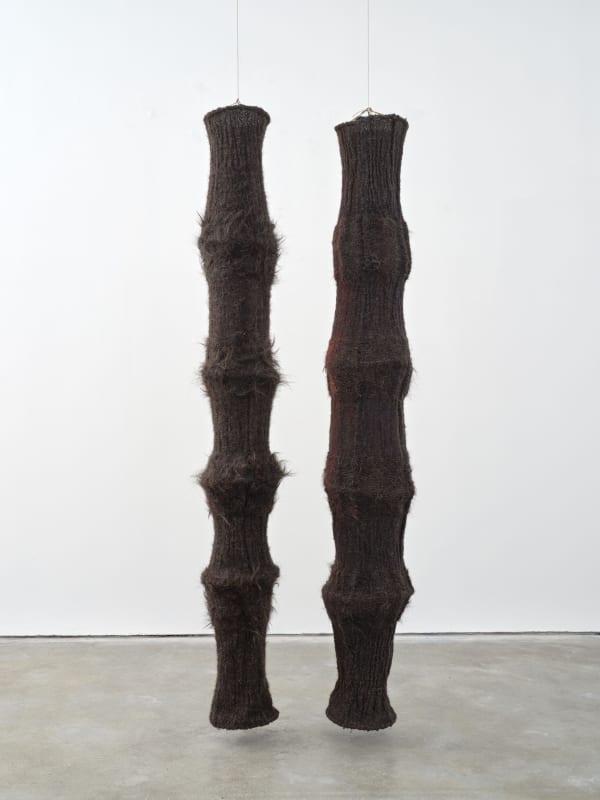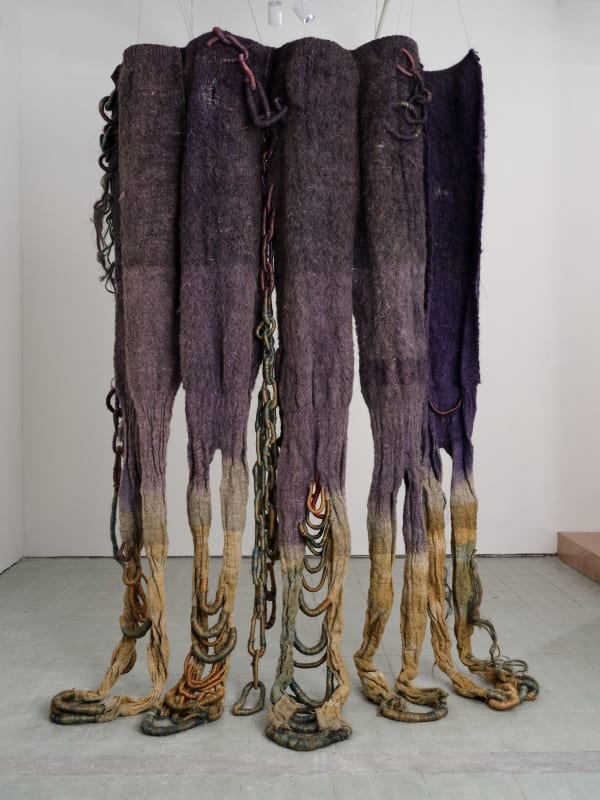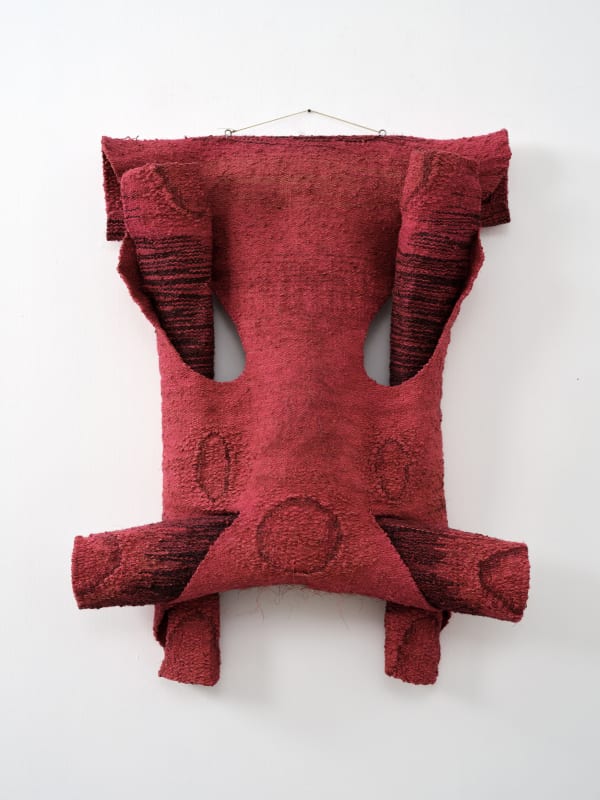Overview
"The Threads of Destiny" presents the remarkable artistic partnership of Maryn Varbanov (1932-1989) and Song Huai-Kuei aka Madame Song (1937-2006), China's legendary couple whose life and work helped to transform the cultural landscape of economic reform-era China. Focusing on Varbanov's columns and installations made with a traditional Bulgarian technique - using goat's hair and a cold-water centrifuge to produce felt - loosely resemble crowns of trees in a surreal forest. These seminal works helped bring him to the forefront of the fiber arts movement in Europe in the seventies. Shown alongside are Varbanov and Song's collaborative butterfly wall works of the same period which complement the columns with a definitive Yin energy. These elegant works, inspired by Zhuang Zi's famous butterfly poem, are at once magical and intensely feminine.
The playful and creative collaboration of Song Huai-Kuei and Varbanov not only foregrounds their shared artistic sentiments, but is a natural extension of their shared life and family which took them around the world. Produced in their Cité Internationale des Arts studio in Paris in the 1970s, these works act as precedent to the couple's momentous return to China in the 1980s.
BANK is proud to present this selection of artistic output for the first time in Shanghai where we see the artists' overlapping sensibilities and interests - modern and orthodox, organic and galactic, Eastern and Western, that have helped define their life and legacy.
-
Maryn Varbanov (b 1932, Bulgaria - d 1989, Beijing) was a prestigious artist whose influence stretched from his native Bulgaria, to his adopted home of Paris, and more notably to China, where he was a powerful influence on the formation of the country's avante-garde in its crucial, early years.
In 1951, as one of the first exchange students in liberated China, Varbanov studied at the Central Academy of Fine Arts in Beijing, and went on, against the laws of the day, to wed his translator and minder, the illustrious Madame Song. The couple soon moved Europe with their daughter Boriana in 1959. It was then that Varbanov founded Sofia Academy of Art's first tapestry department where experimentations in woven sculptures took place. He pioneered the genre of "soft sculpture" - now known as "fiber art" - by subversively re-appropriating the decorative art of tapestry and interrogating its underlying architectonic structure. Varbanov went on to show his visionary textile works at three consecutive International Biennales in Lausanne as well as at the prestigious Musee d'Art Moderne de la Ville de Paris, Galerie Etienne de Causans, Galerie Herve Odermatt, and The Grand Palais.
Song Huai-Kuei upon arrival in Europe went on to finish her studies at the Sofia Academy of Art and graduated in 1962. Afterwards she worked with Varbanov as well as in Bulgaria's burgeoning fashion industry. She continued to skirt both the worlds of art and fashion as the couple shuttled between Sofia and Paris. In 1979 the famous fashion designer Pierre Cardin collected several of Varbanov's work at the FIAC art fair in Paris. The couple was immediately invited to Cardin's newly opened Espace Cardin in NYC where Varbanov exhibited his works and Madame Song began a lifelong collaboration with Cardin. Song not only ushered Cardin and his high fashion label into China but was also responsible for China's first fashion shows and modeling agencies. She was also the illustrious host at Cardin's Maxim's restaurant on Chongwenmen in Beijing, who welcomed a long trail of international cultural and political elite till her death in 2006.
In the early 1980s Varbanov generously donated an atelier at Cité Internationale des Arts to what is now know as the China Academy of Art, singlehandedly welcoming an otherwise isolated China to the global art community. In 1985 Varbanov organized and participated, along with several young Chinese artists, in the Modern Artistic Tapestry Exhibition at the Museum of Fine Arts in Beijing. The show ran concurrent with Robert Rauschenberg's momentous China debut. Curator Hou Hanru quotes Rauschenberg at the time saying that the "soft sculpture exhibition was one of the best shows he had ever seen". In 1986, Varbanov was then invited to establish the Institute of Art Tapestry Varbanov (IATV) at the China Academy of Art in Hangzhou. Underscoring the identity of tapestry as an imported good, the artist drew from both Chinese and Eastern European trade histories. He interlaced Hellenic, Slavic, and Ottoman knitting sensibilities with traditional Chinese silk and wool weaving and inadvertently helped to lay the foundation for installation as an art form in China. Some of his notable students and admirers were Hou Hanru, Gu Wenda, Liang Shaoji, Shi Hui and many others. Varbanov passed away in 1989 but IATV still is alive and active in Hangzhou, recently initiating an international Triennial of Fiber Art in his honor.
Throughout their artistic practice, personal lives, and influence, Varbanov and Song delicately negotiated between East and West; local and international; tradition and the avant-garde, embodying duality itself as an essential feature to their life and legacy. BANK is very honored to have the opportunity to showcase this collaboration for the first time in Shanghai.
The playful and creative collaboration of Song Huai-Kuei and Varbanov not only foregrounds their shared artistic sentiments, but is a natural extension of their shared life and family which took them around the world. Produced in their Cité Internationale des Arts studio in Paris in the 1970s, these works act as precedent to the couple's momentous return to China in the 1980s.
BANK is proud to present this selection of artistic output for the first time in Shanghai where we see the artists' overlapping sensibilities and interests - modern and orthodox, organic and galactic, Eastern and Western, that have helped define their life and legacy.
-
Maryn Varbanov (b 1932, Bulgaria - d 1989, Beijing) was a prestigious artist whose influence stretched from his native Bulgaria, to his adopted home of Paris, and more notably to China, where he was a powerful influence on the formation of the country's avante-garde in its crucial, early years.
In 1951, as one of the first exchange students in liberated China, Varbanov studied at the Central Academy of Fine Arts in Beijing, and went on, against the laws of the day, to wed his translator and minder, the illustrious Madame Song. The couple soon moved Europe with their daughter Boriana in 1959. It was then that Varbanov founded Sofia Academy of Art's first tapestry department where experimentations in woven sculptures took place. He pioneered the genre of "soft sculpture" - now known as "fiber art" - by subversively re-appropriating the decorative art of tapestry and interrogating its underlying architectonic structure. Varbanov went on to show his visionary textile works at three consecutive International Biennales in Lausanne as well as at the prestigious Musee d'Art Moderne de la Ville de Paris, Galerie Etienne de Causans, Galerie Herve Odermatt, and The Grand Palais.
Song Huai-Kuei upon arrival in Europe went on to finish her studies at the Sofia Academy of Art and graduated in 1962. Afterwards she worked with Varbanov as well as in Bulgaria's burgeoning fashion industry. She continued to skirt both the worlds of art and fashion as the couple shuttled between Sofia and Paris. In 1979 the famous fashion designer Pierre Cardin collected several of Varbanov's work at the FIAC art fair in Paris. The couple was immediately invited to Cardin's newly opened Espace Cardin in NYC where Varbanov exhibited his works and Madame Song began a lifelong collaboration with Cardin. Song not only ushered Cardin and his high fashion label into China but was also responsible for China's first fashion shows and modeling agencies. She was also the illustrious host at Cardin's Maxim's restaurant on Chongwenmen in Beijing, who welcomed a long trail of international cultural and political elite till her death in 2006.
In the early 1980s Varbanov generously donated an atelier at Cité Internationale des Arts to what is now know as the China Academy of Art, singlehandedly welcoming an otherwise isolated China to the global art community. In 1985 Varbanov organized and participated, along with several young Chinese artists, in the Modern Artistic Tapestry Exhibition at the Museum of Fine Arts in Beijing. The show ran concurrent with Robert Rauschenberg's momentous China debut. Curator Hou Hanru quotes Rauschenberg at the time saying that the "soft sculpture exhibition was one of the best shows he had ever seen". In 1986, Varbanov was then invited to establish the Institute of Art Tapestry Varbanov (IATV) at the China Academy of Art in Hangzhou. Underscoring the identity of tapestry as an imported good, the artist drew from both Chinese and Eastern European trade histories. He interlaced Hellenic, Slavic, and Ottoman knitting sensibilities with traditional Chinese silk and wool weaving and inadvertently helped to lay the foundation for installation as an art form in China. Some of his notable students and admirers were Hou Hanru, Gu Wenda, Liang Shaoji, Shi Hui and many others. Varbanov passed away in 1989 but IATV still is alive and active in Hangzhou, recently initiating an international Triennial of Fiber Art in his honor.
Throughout their artistic practice, personal lives, and influence, Varbanov and Song delicately negotiated between East and West; local and international; tradition and the avant-garde, embodying duality itself as an essential feature to their life and legacy. BANK is very honored to have the opportunity to showcase this collaboration for the first time in Shanghai.
Installation Views
Works
Press













